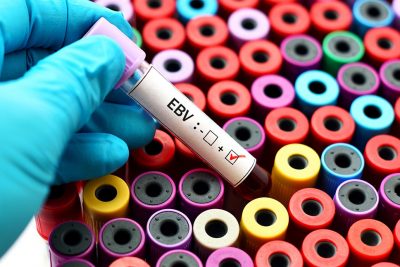
Epstein-Barr Virus and Pediatric Sepsis
October 1, 2025
By Philip R. Fischer, MD, DTM&H
Synopsis: A recent study of 320 children with sepsis suggests that previous Epstein-Barr virus infection is causally associated with immune dysregulation and fatal outcomes.
Source: Sriram A, Kernan KF, Qin Y, et al. Epstein-Barr virus seropositivity, immune dysregulation, and mortality in pediatric sepsis. JAMA Netw Open. 2025;8(8):e2527487.
During the first decades of life, most children are infected by Epstein-Barr virus (EBV), with the result that 40% to 90% of children and 90% of adults are seropositive with anti-EBV antibodies. Seropositivity for EBV is associated with chronic conditions of immune dysregulation, including multiple sclerosis, systemic lupus erythematosus, and some cancers. It is thought that latent EBV infection alters programming of epithelial and immune cells and, thus, leads to immune dysregulation.
Since latent EBV infection seems linked to chronic immune dysregulation, Sriram and colleagues postulated that latent EBV infection also might be related to acute immune dysregulation and, thereby, increase the risk of poor outcomes with sepsis in children.
Blood samples for biomarkers were obtained 24-48 hours after presentation in 320 children with sepsis in the nine centers of a pediatric critical care collaborative network in the United States from 2015 through 2018. Assays and data analysis were completed more recently.
C-reactive protein, ferritin, and 32 cytokines (all biomarkers of inflammation), ex vivo tumor necrosis factor response to endotoxin (a biomarker of immune depression), ADAMTS13 activity (a biomarker of thrombotic microangiopathy), and EBV viral capsid immunoblobulin G (IgG) (as a biomarker of EBV seropositivity) were assayed. Associations between test results and death were noted. Causal inference analyses were completed to determine causal associations.
Of the 320 children with sepsis studied, the median age was 6 years, 54% were male, 47% had been previously healthy, and 23% had evidence of being immunocompromised on admission. Among EBV seropositive children, 15% died; among EBV seronegative children, 3% died. EBV seropositivity was causally associated with inflammation, immune dysregulation, and death.
The authors take these results to imply that EBV infection causes acute immune dysregulation with potentially severe clinical consequences. They find these data to provide compelling impetus to develop effective EBV vaccinations. They also see potential for ongoing development of medications that could therapeutically counter EBV-induced immune dysregulation.
Commentary
EBV is nearly ubiquitous. Infection in adolescents and young adults is so common that some people consider getting “mono” to be a rite of passage during the adolescent years. While EBV-related infectious mononucleosis usually is considered to be a mild, self-limited infection, it can lead to prolonged fatigue and reduced activity. (I missed playing basketball during my senior year of high school due to EBV infection.) These new data provide a stark reminder that EBV sometimes predisposes to other severe acute diseases, even in seemingly healthy individuals.
EBV infection alters immunity in ways that predispose to cancers.1 The “two hit hypothesis” linking Burkitt lymphoma in African children with EBV and malaria was documented in the 1960s. Relationships between EBV and other cancers, including nasopharyngeal carcinoma, were identified subsequently. Reactivated EBV leads to circulating EBV-deoxyribonucleic acid (DNA), which varies in concentration with the effectiveness of the response to cancer treatment.2
The association between EBV and severe malaria during childhood and pregnancy still is relevant to clinical care in Africa.3,4 Thus, it is not surprising that immune alterations related to EBV also would be relevant to severe sepsis in children.
DNA polymerase inhibitors such as ganciclovir have some effect on EBV, but these agents have not provided significant clinical utility.5 Providing a histone deacetylase inhibitor (to push EBV from a latent to a lytic phase) and then giving a DNA polymerase inhibitor to kill the activated EBV shows promise of potential effectiveness.5 These and other small organic molecules hold potential in treating EBV-associated cancers, but the relevance of these products in the treatment of latent EBV-induced immune dysregulation is uncertain.5
Thus far, no EBV vaccine has achieved adequate clinical effectiveness in preventing either EBV infection or EBV-associated diseases.6 Research continues with several sorts of potential vaccines.6
Sriram and colleagues remind us that sepsis accounts for approximately 20% of deaths worldwide, and EBV is a significant contributor to those deaths. Good treatment of sepsis is needed, and eventual application of EBV-directed medications and EBV-preventing vaccines might further help reduce the mortality of sepsis.
Philip R. Fischer, MD, DTM&H, is Professor of Pediatrics, Department of Pediatric and Adolescent Medicine, Mayo Clinic, Rochester, MN.
References
1. Alsaadawe M, Radman BA, Long J, et al. Epstein Barr virus: A cellular hijacker in cancer. Biochim Biophys Acta Rev Cancer. 2024;1879(6):189218.
2. Wang L, Xu G, Xu J, Zhang Q. Clinical significance of plasma and peripheral blood mononuclear cell EBV-DNA in lymphoma. J Clin Lab Anal. 2025;Aug 13:e70092. doi: 10.1002/jcla.70092. [Online ahead of print].
3. Cheng WT, Fogang B, Jain A, et al. Acute Epstein Barr virus is a risk factor for severe malaria in infants under 24 months. medRxiv. 2025; Apr 30:2025.04.29.25326585. doi: 10.1101/2025.04.29.25326585. [Preprint]
4. Djuidje Chatue IA, Nyegue MA, Kamdem SD, et al. Association between Epstein-Barr virus reactivation and severe malaria in pregnant women living in a malaria-endemic region of Cameroon. PLOS Glob Public Health. 2024;4(8):e0003556.
5. Oumata N, Zhong Q, Zhang Y, et al. Emerging drugs for Epstein-Barr virus-associated diseases. Eur J Med Chem. 2025;287:117386.
6. Dai Y, Zhang B, Yang L, et al. Recent progress in the vaccine development against Epstein-Barr virus. Viruses. 2025;17(7):936.